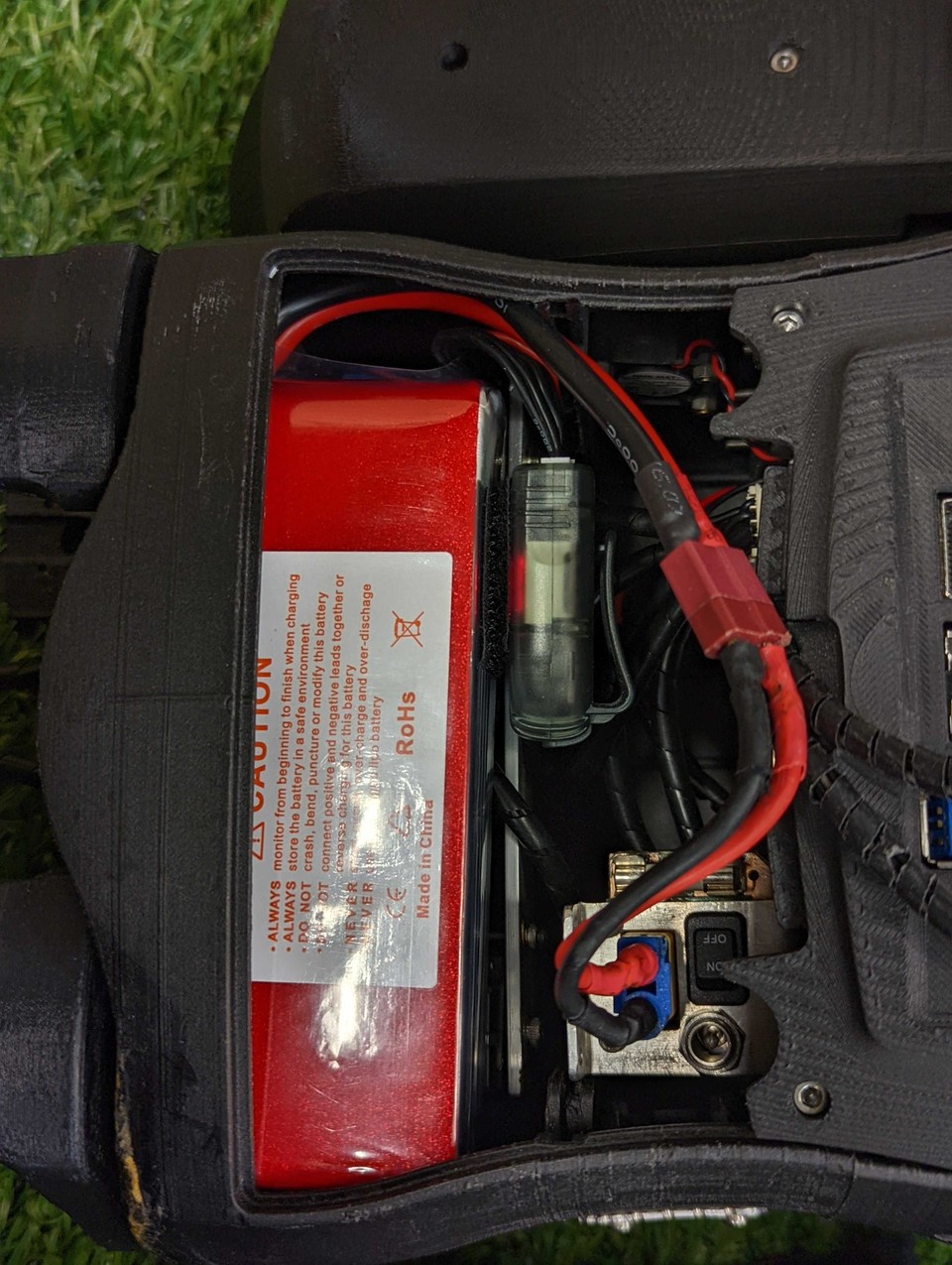Battery Safety
Our robots have the capability to run on both battery power and by plugging into a power supply. The robots should be run on battery power for events such as RoboCup, RoboCup qualification videos, lab inductions, and other times where a cable attached to the robot may interfere with its operation. During standard testing in the lab, you will usually have the robot running off a power supply.
Our NUgus robots run on 4 Cell 14.8V Lithium Polymer (LiPo) batteries, whilst the Darwin robots use a smaller 3 Cell 11.1V model. In order to handle batteries in the lab you should have completed a formal lab induction.
LiPo batteries can be extremely volatile and should always be handled with the utmost care. When not being used, they should be kept in fire retardant bags and stored carefully in either the "Flat" or "Charged" drawer depending on its current state. After use, a battery should be be inspected for any physical damage, and clearly marked and set aside if any is present.
Using in the robot
Whenever a battery is being used in the robot, it should be additionally connected to a battery monitor. This will provide an audible warning when the battery is low voltage so that it can be unplugged before it becomes unusably flat. Unlike regular batteries, LiPo batteries cannot run completely flat unless they are due to be disposed of.
To connect a battery monitor to the battery:
Start by finding the cable on the battery with the white plug. Line up the
-symbol on the monitor with the 5 black leads of the battery cable, and plug in. Be aware that the battery monitor will beep several times when this happens, this is normal.![Battery monitor attached to a battery]()
Once the battery monitor is attached to the battery, the other cable on the battery can now be plugged into the robot. Depending on the battery this may require an adaptor lead, shown below.
Once both cables on the battery are hooked up, install the battery into the robot and install the back panel cover. Be sure to carefully load the battery into the robot to avoid damage, this may require some technique so don't be afraid to ask a team member for the best way to go about this.
The robot can now be safely turned on.

Charging
We have two types of chargers in the lab to charge LiPo batteries. Both achieve the same purpose and have a similar user interface. The Powertech Plus charger will be used for the purposes of the images below.
Charging a battery
Plug the battery cable with the white plug into the corresponding socket on the side of the charger. The plug should only fit in one orientation so check before plugging it in. If you find yourself forcing the plug into the socket you are doing something wrong.
Plug the other battery cable into the main output cable of the charger, this may require an adaptor, as seen in the section on using in the robot
Plug the Powertech Plus into a power socket, and use the arrow buttons to select the "Charging" setting for the type of battery you are charging. For the NUgus robot battery this is a 14.8V 4 Cell, as seen in the image below. For a Darwin robot battery, this is a 11.1V 3 Cell.
Hold down the start button until the device beeps, and observe the content on the screen. If the charging device indicates any errors, stop charging immediately, unplug the battery, and return it to a fire retardant case. If there are no errors, press start to commence charging
Close and lock the white BAT-SAFE box with the battery inside (Keep the charger outside if possible to hear when it is done)
Stay in the lab with the battery and disconnect immediately when charge has completed. Never leave a battery charging when there is no one in the lab

Storing and Traveling with batteries
Care should be taken to verify the LiPo battery limits of the airline you are travelling with. They will usually specify a maximum Wh value for all batteries and
possibly a maximum number of batteries. The Wh value of your batteries can be calculated by the formula Wh = V * Ah. If you are found carrying more than the
allowed limit then you will likely need to discard the batteries and not fly with them.
When travelling, LiPo batteries should always be kept in fire retardant bags, with one battery stored in each fire retardant bag. If travelling on an aircraft, LiPo batteries should always go in carry-on luggage, never in checked luggage. It is important to prepare batteries for storage when travelling on an aircraft. Batteries should also be prepared for storage when being stored in the lab for an extended period of time.
In both cases, preparing a battery for storage is done by following the same process outlined for charging, however by using the "Storage" setting, as seen in the image below.

Disposal of batteries
If a battery has been physically damaged or is showing errors when attempting to charge, it should be disposed of. Batteries for disposal should be taken in a fire retardant bag to the Electrical Engineering building on campus. Talk to the team leader to confirm the most up to date details of where to take them.
If the cables on the battery are damaged, it is a good idea to wrap the damaged sections separately in electrical tape to prevent them short cicruiting against each other inside the fire retardant bag.


